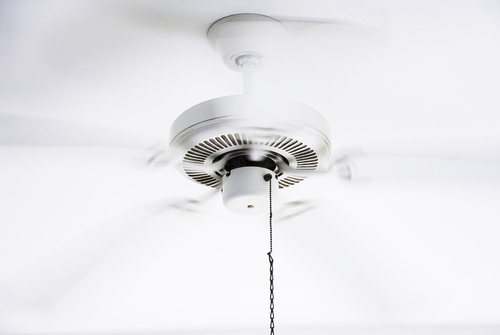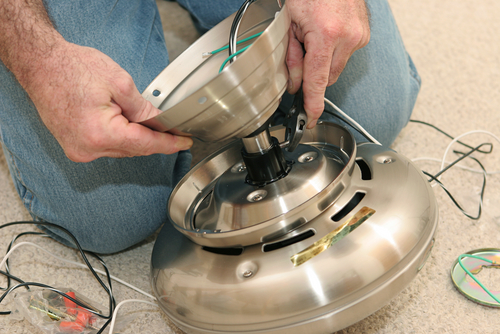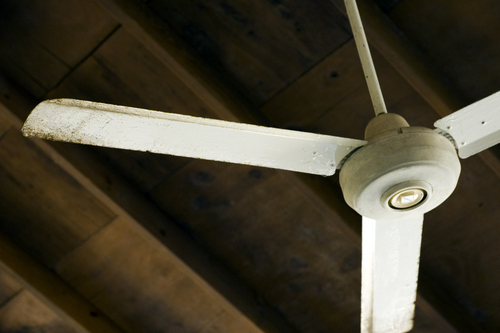 |
What Are The Best
Kept Secrets About Ceiling Fan?
|
Ceiling fan is a mechanical fan that is normally installed
on the roof of a room. It is usually powered by electricity
and designed to rotate significantly and slower than the
desk-fan. The ceiling fan makes the air to circulate around
a building or a room. It sometimes has light fittings
attached to it which is meant to replace the need for a
standard light shade. It is important to note that
commercial ceiling fan can save a significant amount of
energy and can push the air around more significantly.
Ceilings fans were initially activated with the use of a
pull cord or a chain but modern fans uses switches or dials
that are usually mounted on a wall or any other convenient
position. They do wobble when their blades are out of
balance but are stable enough that they are unlikely to
fall. Some of them are capable of being switched to rotate
in the opposition direction such that they can be used
especially during the relatively cold season.

A ceiling fan can further be described as an appliance
wrapped in furniture. The motor, which is an important part
of ceiling fan, has varied size and quality and the housing
offers several styles and colors that can be chosen from.
Fan’s blades can be made of particle-board with a wall paper
for color and in real furniture grade hardwood-veneers.
Stacks are known to be more open and more cooling than the
common motors. Another common motor known as Pancake, varies
considerably in size and are mostly affected by heat
build-up than the stack motors. Heat build-up is a
disadvantage to your components because it may shorten the
life span of such components and even may cause winding to
get loosen due to the vibrating sound produce by the motor.
A ceiling fan produces some noise. This originates from the
motor which determines how quiet the fan is and how much air
does the ceiling fan will move. It is not a general
conclusion that the ceiling will develop a sound but can
also depend on the maintenance of that ceiling fan. A
quality fan which is well maintain should not be noisy due
to finer machine-parts, but this can also get out of balance
or may have a loose light kit causing it to produce some
sound.
Ceiling fan has more advantageous over the central air
conditioning system. Air conditioners are known to use more
electricity than a fan. It uses an average of 3500 watts of
power while in use and a room air conditioner can use up to
1,000 watts as compared to a ceiling fan which can use about
50 watts when turn on high uses. The makers of a ceiling fan
are continuously improving designs and features to make the
product to be more energy saver, more appealing and quieter.

A ceiling fan has important facts worth to know which
include the following;
· Helps in keeping the room warm. The fan’s blades can
reverse in an opposite direction or to clockwise direction
during a cold weather condition. This causes the rising warm
to be push down to where you and your family are.
· Fans ensure that the room temperature remains constant.
Unlike air conditioners which are designed to kick in and
out the air, when thermostat settings gives them an
indication that the temperature is too high or too low.
Ceiling fan just circulates the air in order to maintain
room temperature at a constant level even during the hottest
times of the day.
· Variety of sizes. Ceiling fans are available in different
sizes with its possible sizes ranging from 32 inches to 52
inches. You need to choose a fan which best suit the
available space for your room. For instance, if your room is
more than 500 square feet, then you need to have a more than
52 ceiling fan which can effectively and conveniently.
· The significance of blade’s angles. The angles of the
blade can make great difference in air circulation. As a
matter of fact, blades’ angles should be at a minimum of 12
degrees for them to be effective functioning. Blades which
are set at angles of 16 degrees will keep you cool but may
cause disturbances because they may blow loose objects like
the papers around the room.
· Fans normally work with the central air. Air conditioning
blasting, all the time is not necessary especially with the
presence of a ceiling fan. This is because a ceiling fan can
actually complement a central air system but with more
energy savings than the central air system.

Other facts about fans include the following;
· The most decorative fans are design with five blades while
industrial grade ceiling fans normally have three blades and
contain a relatively high-powered motor that may contribute
to an energy savings of about 75 percent or more.
· Another kind of ceiling fan is what is referred to as low
profile ceiling fan which is ideal for lower ceilings rooms.
Installation of this ceiling fan needs to be closer to the
ceiling where there is no obstruction of blade rotation.
Note that they are unsuitable for vaulted ceilings.
There many more types of ceiling fans available in Singapore
which are left unmentioned, but what is suitable for
Singapore is either of the above discussed ceiling fans of
which one is only needed to consider the location, the kind
of ceiling, maintenance and among other factors. What is
only required of you before buying a ceiling fan is to first
set budget of how much you are willing to spend, ensure you
measure the space where you intend to install it and take
into considerations the specification of a ceiling fan that
you need. |
|
|
|
|
|
|
|
|
Singapore Leading Home & Office Ceiling
Fan & Lighting Specialists |
|
 |
|
| |
|
Singapore One Stop Solution For All
Types of Ceiling Fan & Lighting Services |
|
|
|
|
|
No Obligation Onsite Quote For
Lighting & Ceiling Fan Services |
 We are Specialists in:
We are Specialists in:
Ceiling Fan, Ceiling Fan with Lights, Designer Ceiling Fan &
Lightings |
|
I just got my keys for my condo and i was
recommended by my colleague Albert to get a
quote from them. Indeed, they got many ceiling
fan designs to choose from and i am very
impressed with their rates and service. Keep up
the superb work guys. |
|
Mr & Mrs Chew (Punggol) |
|
|
 |
|
|
|
|
|
|
|
|
|

